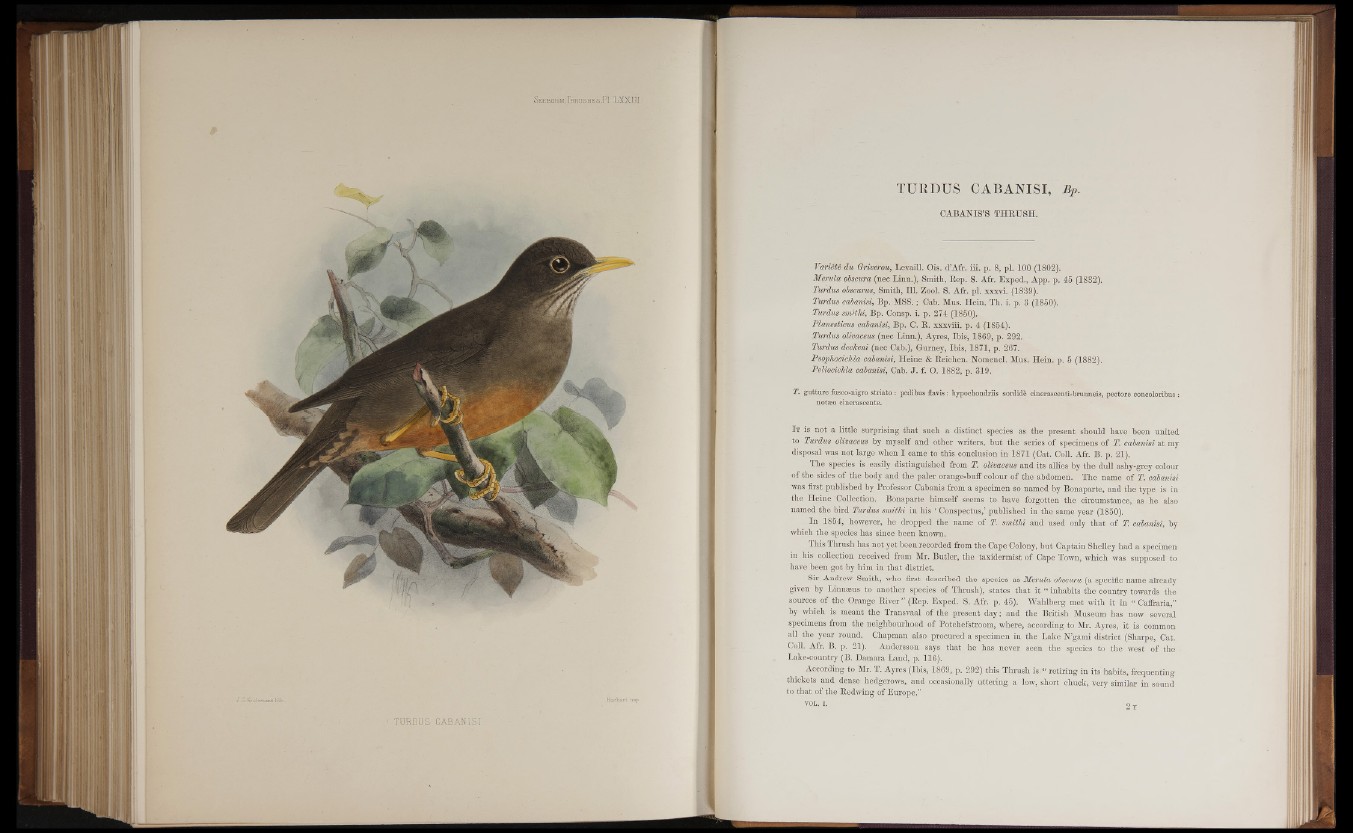
H il i l ! i s I i l
t i
TORDUS CABANIST.
TURDUS CABANISI, Bp.
CABANIS’S THRUSH.
Variété du Griverou, Levaill. Ois. d’Afr. iii. p. 8, pi. 100 (1802).
Merula obscura (nee Linn.), Smith, Rep. S. Air. Exped., App. p. 45 (1832).
Turdus obscurus, Smith, 111. Zool. S. Afr. pi. xxxvi. (1839).
Turdus cabanisi, Bp. MSS. ; Cab. Mus. Hein. Th. i. p. 3 (1850).
Turdus smithi, Bp. Consp. i. p. 274 (1850).
Planesticus cabanisi, Bp. C. R. xxxviii. p. 4 (1854).
Turdus olivaceus (nec Linn.), Ayres, Ibis, 1869, p. 292.
Turdus deckeni (nec Cab.), Gurney, Ibis, 1871, p. 267.
Psophocichla cabanisi, Heine & Reicben. Nomencl. Mus. Hein. p. 5 (1882).
Peliocichla cabanisi, Cab. J. f. O. 1882, p. 319.
T. gutture fusco-nigro striato : pedibus flavis : hypochondriis sordide cinerascenti-brunneis, pectore concoloribus :
notæo cinerascente.
I t is not a little surprising that such a distinct species as the present should have been united
to Turdus olivaceus by myself and other writers, but the series of specimens of T. cabanisi at my
disposal was not large when I came to this conclusion in 1871 (Cat. Coll. Afr. B. p. 21).
The species is easily distinguished from T. olivaceus and its allies by the dull ashy-grey colour
of the sides of the body and the paler orange-buff colour of the abdomen. The name of T. cabanisi
was first published by Professor Cabanis from a specimen so named by Bonaparte, and the type is in
the Heine Collection. Bonaparte himself seems to have forgotten the circumstance, as he also
named the bird Turdus smithi in his ‘ Conspectus,’ published in the same year (1850).
In 1854, however, he dropped the name of T. smithi and used only that of T. cabanisi, by
which the species has since been known.
This Thrush has not yet been recorded from the Cape Colony, but Captain Shelley had a specimen
in his collection received from Mr. Butler, the taxidermist of Cape Town, which was supposed to
have been got by him in that district.
Sir Andrew Smith, who first described the species as Merula obscura (a specific name already
given by Linnæus to another species of Thrush), states that it “ inhabits the country towards the
sources of the Orange River I (Rep. Exped. S. Afr. p. 45). Wahlberg met with it in “ Caffearia,”
by which is meant the Transvaal of the present day ; and the British Museum has now several
specimens from the neighbourhood of Potchefstroom, where, according to Mr. Ayres, it is common
all the year round. Chapman also procured a spécimen in the Lake N’gami district (Sharpe, Cat.
Coll. Afr. B. p. 21). Andersson says that he has never seen the species to the west of the
Lake-country (B. Darnara Land, p. 116)>
According to Mr. T. Ayres (Ibis, 1869, p. 292) this Thrush is “ retiring in its habits, frequenting
thickets and dense hedgerows, and occasionally uttering a low, short chuck, very similar in sound
to that of the Redwing of Europe.”
VOL. I. £ y